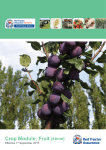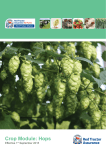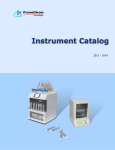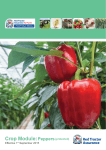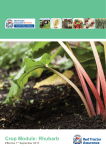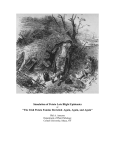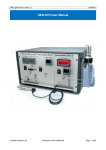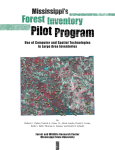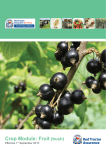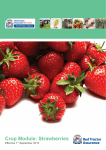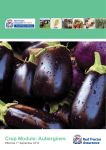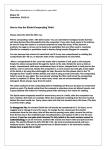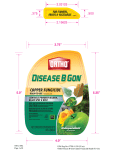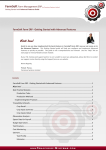Download Crop Module: Fruit (top)
Transcript
Crop Module: Fruit (top) Effective 1st September 2015 Welcome T his crop specific module for top fruit has been written to complement and avoid duplicating the generic principles of the Red Tractor Farm Assurance Fresh Produce Scheme standards. It is advisable to read the Red Tractor Farm Assurance Fresh Produce standards before reading this crop specific module. This module is designed to stimulate thought in the mind of the reader. It contains crop specific guidance and standards, where applicable, in addition to the requirements stated in the generic Fresh Produce standards. Within this module the important requirements outlined in the crop specific standards section will be verified during the Red Tractor Farm Assurance assessment and compliance will form a part of the certification/approval decision. Disclaimer and trade mark acknowledgement Although every effort has been made to ensure accuracy, Assured Food Standards does not accept any responsibility for errors and omissions. Trade names are only used in this module where use of that specific product is essential. All such products are annotated® and all trademark rights are hereby acknowledged. General Introduction Following a systematic approach will help growers identify and manage the risks involved in crop production. This module is based on a typical crop production process and food safety, health & safety, environmental and quality hazards are identified. Appropriate controls may then be established to minimise risk. Food safety and health & safety issues always take precedent over quality and environmental controls. The layout of this module follows the same structure as that used in the Red Tractor Farm Assurance Fresh Produce Standards. The content of the module is reviewed prior to the issue of updated editions. The review process considers both new developments and all relevant technology which has emerged since the last review was completed and which have been found to be both workable by the grower and beneficial to the environment. The aim is to transfer such information and technologies to growers. Acknowledgements Red Tractor Farm Assurance Fresh Produce gratefully acknowledges the contribution of all consultees in the preparation of this protocol, particularly Tim Biddlecombe of FAST. Notes: Pesticide Information The Red Tractor Fresh Produce team has been working with Fera to provide tailored access to the LIAISON database for all Red Tractor Fresh Produce members. This system allows individual growers access to all information for plant protection products approved for use under the Red Tractor Fresh Produce Scheme. LIAISON can be accessed under the Produce tab via the “Checkers and Services” page where you will also find a user manual. Searches will be filtered specifically for the crops for which you are registered. Once you have logged onto the site and clicked on the LIAISON hyperlink you will be directed to the LIAISON home screen. You will need a username and password and these will be sent once you have registered: http://assurance.redtractor.org.uk/rtassurance/ services/Registration/members.eb Front cover image credit: Tim Biddlecombe of FAST. 1 Red Tractor Assurance for Farms – Crop-specific Module: Fruit (top) © Assured Food Standards 2015 Content Contents ADDITIONAL REQUIREMENTS AGAINST CURRENT STANDARDS 02 CROP SPECIFIC STANDARDS02 SITE AND SOIL MANAGEMENT 03 ENVIRONMENTAL PROTECTION AND CONTAMINATION CONTROL03 PEST, DISEASE AND WEED CONTROL 06 NUTRITION 12 HARVEST AND STORAGE 12 RESIDUES AND CONTAMINANTS 17 APPENDIX 1: B CPC’S CHART OF CONDITIONS WHICH CONTROL THE USE OF REDUCED SPRAY (DILUTENT)18 APPENDIX 2: RECORDS AND RISK ASSESSMENTS19 APPENDIX 3: GUIDELINES FOR MINIMISING PESTICIDE RESIDUES31 ADDITIONAL REQUIREMENTS AGAINST CURRENT STANDARDS None for this crop module CROP SPECIFIC STANDARDS None for this crop module Red Tractor Assurance for Farms – Crop-specific Module: Fruit (top) © Assured Food Standards 2015 2 GUIDANCE SITE AND SOIL MANAGEMENT All orchards should be adequately protected by deciduous wind breaks/hedges to ensure a good microclimate in the orchard and minimise spray drift. Specific LERAP regulations apply to using broadcast air-assisted sprayers so growers wishing to reduce buffer zones need to follow these regulations. Pest/Disease/Weed CHOICE OF PLANT PROTECTION PRODUCT When choosing a product the most environmentally benign that provides effective control should be selected. Products listed as safe (S) or moderately safe (MS) to typhs should be used in apple orchards, and only those listed as safe or moderately safe to anthocorids should be used between 2 weeks after petal fall and harvest in pear orchards. Approved products in order of preference Active ingredient Products include Scab Mildew No preferred products. Avoid multiple applications of the same active ingredient to preserve typhs and reduce risk of resistance Blossom wilt Fenbuconazole Indar Pyrimethanil Scala (only approved for scab but has effect on Blossom wilt) Pirimicarb Aphox, Phantom Flonicamid Mainman Acetamiprid Gazelle Thiacloprid Calypso Chlorpyrifos Equity Lorsban Methoxyfenozide Runner Diflubenzuron Dimilin Chlorpyrifos Equity, Dursban Bacillus thuringiensis Dipel - DF Sawfly Thiacloprid Calypso Codling moth Methoxyfenozide Runner Chlorantraniliprole Coragen Diflubenzuron Dimilin Fenoxycarb Insegar Codlemone Exosex Chlorpyrifos Equity Lorsban Fenoxycarb Insegar Methoxyfenozide Runner Indoxacarb Steward Bacillus thuringiensis Dipel - DF Methoxyfenozide Runner Diflubenzuron Dimilin Bacillus thuringiensis Dipel - DF Fenoxycarb Insegar Chlorpyrifos Equity Aphids Winter moth caterpillars Summer fruit tortrix Fruit tree tortrix 3 ENVIRONMENTAL PROTECTION & CONTAMINATION CONTROL Red Tractor Assurance for Farms – Crop-specific Module: Fruit (top) © Assured Food Standards 2015 Pest/Disease/Weed Approved products in order of preference Active ingredient Products include Capsids Thiacloprid Calypso Fruit tree red spider mite Clofentezine Apollo Fenpyroximate Sequel (apple only) Tebufenpyrad Masai Thiacloprid Calypso Chlorpyrifos Equity, Lorsban Scale insects Thiacloprid Calypso Rustmite Sulphur(nymphs) Blossom Weevil Pear sucker Residual herbicides Contact herbicides Spirodiclofen Envidor Fenpyroximate Sequel Tebufenpyrad Masai Sulphur Diflubenzuron Dimilin Spirodiclofen Envidor Oxadiazon Ronstar Pendimethalin Stomp Glufosinate ammonium Challenge Glyphosate Glyfos Note: Not all formulations of these products may be currently approved for use on Top Fruit. Check before use. APPROVED USES NOT INCLUDED ON THE PRODUCT LABEL In many circumstances, particularly for minor crops, product labels do not include all of the approved uses and growers wishing to check the approval notice of a particular product should note that this information is available using the LIAISON® search accessible via their RED TRACTOR Farm Assurance home page after logging in. A search on the ‘Extension of Authorisation for Minor Use’ page of LIAISON® by crop or product name should yield a results page. A click on the product name should link to a summary of the approval information. Near the bottom of the summary is the specific off-label number (e.g. 0246/09) and this link will open up a pdf of the current EAMU document giving details of the extension of use. Roundup, Gallup Glyphogan Pesticide applications Pesticide application records should be completed as the spray programme is applied to the orchard. A copy of each record should be forwarded to the marketing organisation that is to handle the fruit as soon as convenient (no later than the first harvest date of the fruit). The original should be retained by the grower for reference and to fulfil the legal requirements. Where a common basic spray programme is used across a whole farm it is in order to record the base programme which covers all orchards once only and to record special treatments for individual orchards on an exceptional basis. The pesticide application record should include the following: Date: State the date of application. Time: State start time and finish time of each spraying operation. Records of application Variety(s): State the varieties covered. Although suggested layouts have been provided in the Appendix for recording orchard details and pesticide treatments, computerised record keeping systems are quite acceptable provided that they capture equivalent information. Product: State full trade name of pesticide as printed on the label. Rate: At the top of the ‘Rate’ column enter the units to be used (quantity of pesticide per unit area), and in the rows the volume of spray applied per unit area. Red Tractor Assurance for Farms – Crop-specific Module: Fruit (top) © Assured Food Standards 2015 4 Volume: At the top of the ‘Volume’ column enter the units to be used (volume of spray per unit area), and in the rows the volume of spray applied per unit area. Operator Name: State the operator’s name to enable monitoring of exposure to pesticides. Target Pest: State target pest, disease or weed, e.g. rosy apple aphid. Justification: State pest or disease level or risk as justification for treatment. Weather: The wind speed should be measured at the top of the windbreak and divided by two to give an estimate of the wind speed at crop level. The wind force should be recorded according to the Beaufort Scale, i.e. 0.Calm. Smoke rises vertically. 1.Direction of wind shown by smoke drift but not by wind vanes. 2. Wind felt on face. Leaves rustle. Ordinary vane moved by wind. 3.Leaves and twigs in constant motion. Wind extends light flags. 4. Raises dust and loose paper. Small branches are moved. 5.Small trees in leaf begin to sway. Crested wavelets form on inland waters. Spraying should not take place if the wind force is greater than force four. Spraying at force zero is not recommended either. Under DEFRA’s Code of Practice foliar sprays should only be applied at wind speeds up to force 2 and 3 and herbicides at force 2. Any other relevant weather conditions should also be entered. First permitted harvest date To calculate the first permissible harvest date, refer to the product label and add the appropriate number of days to the date on which it was applied. The first permissible harvest date should be entered and brought forward as a ‘rolling date’ in the spray records. Care should be taken when applying sprays in orchards with early season varieties in order to comply with the minimum harvest interval. 5 Post-harvest chemical treatments A post-harvest chemical treatment record should be completed if the fruit is drenched at harvest time by the grower or packhouse as appropriate. Again a copy should be forwarded immediately to the marketing organisation which is to handle the sale of the fruit. The original should be retained by the grower or packhouse for reference and to fulfil the legal requirements. Where a common treatment programme is used across a whole farm or packhouse it is in order to record the base programme which covers all orchards once only and to record special treatments for individual orchards on an exceptional basis. The post-harvest chemical treatment record should include the following: Farm: State the farm where the fruit was grown. Orchard: State the orchard where the fruit was grown. Consignment: State any consignment number. Date: State date of treatment. Storage Date: State the proposed store opening date. Product: State the full trade name as printed on the carton. Rate: At the top of the rate column enter the units to be used (quantity of pesticide per volume of drench), and in the rows the amount of product mixed per unit volume of drench. Operator Name: State the operator’s name to enable monitoring of exposure to pesticides. Target: State the target disease, eg. Phytophthora. Justification: State the level of rot risk as justification for treatment, e.g. very heavy rain at harvest. Sale Date: The first permissible sale date should be entered. This is to be calculated from the date of drenching plus the required interval specified by the manufacturer. A suggested post-harvest chemical treatment recording form is given in the Appendix. Red Tractor Assurance for Farms – Crop-specific Module: Fruit (top) © Assured Food Standards 2015 PEST, DISEASE AND WEED CONTROL PEST CONTROL USING PREDATORY INSECTS Encouraging beneficial insects in the orchard. One of the most important factors in building up and maintaining beneficial insect numbers is the correct choice of pesticide. Providing alternative hosts and food sources, which will be attractive to predators at different times in the season to the crop plants, is a valuable way of encouraging predators within the farm. Leaving grass alleys unmown has been shown to encourage anthocorid numbers in orchards. When planting windbreaks around an orchard or planting up a non-cropping area, give consideration to the types of trees and shrubs chosen. The inclusion of goat willow, hazel and cherry plums alongside the normal alder species will provide food and havens for anthocorids and lacewings. In addition, the use of annual flowering plants, such as Phacelia spp, mustard and wild carrots, sown around headlands or in fallow areas to encourage a wide range of pollinating insects, typhlodromid mites, ladybirds, hoverflies and anthocorids is advised. Increasing biodiversity on the farm is an important factor in building up reliable numbers of predators against a wide range of the pests that can attack fruit crops. Natural predators The key natural predators, i.e. typhlodromid mites on apple and anthocorids on pears should be conserved and encouraged. Red Tractor Assurance for Farms – Crop-specific Module: Fruit (top) © Assured Food Standards 2015 6 Typhlodromus pyri Commonly referred to as ‘typhs’, the nymph and adult forms of this mite are very similar in appearance being pear shaped, with pale, almost translucent smooth bodies, and are about 0.3mm long. Adults have 8 legs and are very active on the underside of the leaf and are often found near the main vein. They prefer hairy leaves and are thus a more important predator on apples than pears. Adult females overwinter in the orchard hiding in the bark of trees and elsewhere. Many die during the winter. In the spring, surviving adults lay eggs on the underside of leaves. Up to four generations may occur in a season. The adults and nymphs eat large numbers of red spidera mites and will even eat rust mite if the red spider mite numbers are low. As they are present all year round in orchards there is no safe time to use insecticides that are not selective to them. Typhs should be introduced into orchards where they are not endemic. The most effective way of doing this is to use summer prunings from orchards that have known populations of typhs. Research has shown that typhs prefer to move along the tree rows in the orchard so the prunings should be placed in each row, up wind to help dispersal. Pesticides (1) known to be harmful to typhs Products containing: cypermethrin Deltamethrin Bifenthrin Lambda - cyhalothrin Pesticides (1) considered to be possibly harmful/harmful to typhs under some circumstances Fungicides (2) MSS Sulphur Flowable® Karamate Dryflo® Microsul Flowable Sulphur® Headland Sulphur® Notes: 7 (1) Not all formulations of each product may be currently approved for use on Top Fruit. Check before use. Label recommendations are revised regularly, read a current label before use. (2) Growers may be able to justify the limited use of these fungicides in specific circumstances but multiple applications should be avoided. Red Tractor Assurance for Farms – Crop-specific Module: Fruit (top) © Assured Food Standards 2015 Anthocoris nemorum (Common flower bug) ADULT NYMPH Commonly referred to as ‘anthocorids’, the adult and nymph form of this predatory bug is about 4mm long. They are dark brown/black and shiny with geometric pale markings, particularly on the adults. The nymphs may have a red colouration, with 6 legs, long antennae and a long pointed mouthpiece. The adults overwinter in a wide range of sites both in and away from orchards. They come out of hibernation from March onwards migrating to willow catkins and lay eggs between March and June with eggs hatching after about 10 days. There are usually two generations. Both adults and nymphs enjoy a varied diet attacking pear sucker, spider mites, midge larvae and caterpillars. In order to conserve endemic populations, the use of products toxic to anthocorids should be avoided from 2 weeks after petal fall to harvest. Pesticides (1) known to be harmful to anthocorids Various All organophosphate insecticides Pyrethoids Products containing cypermethrin Cypermethrin Deltamethrin Bifenthrin Lambda-cyhalothrin Pesticides (1) considered to be safe to anthocorids All fungicides Dimilin® Aphox® Note: (1) Not all formulations of each product may be currently approved for use on Top Fruit. Check before use. Label recommendations are revised regularly, read a current label before use. Red Tractor Assurance for Farms – Crop-specific Module: Fruit (top) © Assured Food Standards 2015 8 Apple and pear pest thresholds Apple pest thresholds Dormant period Bud-burst to mouse ear Green cluster to pink bud Late blossom to petal fall Petal fall onwards Threshold Apple rust mite 10 mites per bud Fruit tree red spider mite winter eggs 30% branch nodes with >5 eggs Apple rust mite 5 mites per outer rosette leaf Rosy leaf curling aphid presence (spot treatment only) Rosy apple aphid presence Apple grass aphid 30% trusses infested Capsid presence Winter moth or tortrix moth caterpillars 5% trusses infested Apple blossom weevil presence (if not seen this year but damage seen last year, then high risk) Rosy apple aphid presence Apple sawfly presence (if not seen this year but damage seen last year, then high risk) Winter moth or clouded drab moth caterpillars 5% trusses infested Apple rust mite 5 mites per leaf Capsid presence Rosy apple aphid presence Blastobasis moth presence (if not seen this year but damage seen last year then high risk) Woolly aphid present on extension growth Green apple aphid 8% shoots infested Clouded drab moth 6% shoots infested Fruit tree red spider mite 2 mites per leaf Apple rust mite 10-50 mites per leaf, higher level later in season Codling moth 5 moths per trap per week in 2 out of 4 weeks 2 moths per week for 2nd generation in August & September 9 Fruitlet mining tortrix moth 10 or more per trap per week Fruit tree tortrix moth 30 or more per trap per week Summer fruit tortrix moth start of flight, i.e. >5 moths per trap per week. Spray at first egg hatch. (The timing between first flight and egg hatch is dependent upon temperature) Red Tractor Assurance for Farms – Crop-specific Module: Fruit (top) © Assured Food Standards 2015 Pear pest thresholds Bud-burst to mouse ear Green bud to white bud Late blossom to petal fall Petal fall onwards Threshold Pear rust mite 5 mites per leaf Pear bedstraw aphid presence Capsid presence Winter moth or tortrix moth caterpillars 5% trusses infested Pear midge presence (if not seen this year but damage seen last year then high risk) Pear bedstraw aphid presence Capsid presence Winter moth or clouded drab moth caterpillars 3% trusses infested Pear rust mite 5 mites per leaf Capsid presence Pear bedstraw aphid 1% trees infested Pear sucker 30% leaves infested with nymphs, slight honeyedew contamination of fruit DISEASE CONTROL Scab assessment Scab assessment Risk level Assessment Situation Not found Pre bloom - end June Early July - harvest Weather unfavourable Very low No risk Not found Weather favourable Moderate Very low, providing control achieved up to end of June Hard to find 1 or 2 leaves or fruit in 100, weather unfavourable High Moderate Hard to find 1 or 2 leaves or fruit in 100, weather favourable Very high High Found 3-5 leaves or fruit in 100 Very high High Easy to find More than 5 leaves or fruit in 100 Very high High Risk level should be entered on pesticide record forms. Notes: When choosing a fungicide account should be taken as to whether it has eradicant or protectant activity. DMI fungicides (eg. Systhane®, Topas®) can be used pre- and immediately post-blossom and as an eradicant following periods of high risk. Scala can be used up to the end of flowering. Dose rates may be reduced below the manufacturer’s recommended maximum level depending on the risk of scab, varietal susceptibility and the time of year. However, before reducing rates the orchard’s past history and the current weather conditions should be taken into account. Warm, wet weather favours scab development. Mildew assessment Primary mildew assessment up to full bloom. Assess 10 trusses on 4 branches on 25 trees per orchard (total of 1000 trusses). % infected Recorded level 0-2 Low 2-5 Medium >5 High Red Tractor Assurance for Farms – Crop-specific Module: Fruit (top) © Assured Food Standards 2015 10 Secondary mildew assessment from petal-fall onwards The level recorded should take into account the growth rate and prevailing weather. Assessment Growth rate Weather Risk level Not found Slow Unfavourable Very low Not found Slow Favourable Low Not found Moderate Unfavourable Very low Not found Moderate Favourable Moderate Not found Strong Unfavourable Low Not found Strong Favourable Moderate Hard to find Slow Unfavourable Low Hard to find Slow Favourable Moderate Hard to find Moderate Unfavourable Low Hard to find Moderate Favourable Moderate Hard to find Strong Unfavourable Low Hard to find Strong Favourable High Found Slow Unfavourable Moderate Found Slow Favourable High Found Moderate Unfavourable Moderate Found Moderate Favourable High Found Strong Unfavourable Moderate Found Strong Favourable Very high Easy to find Slow Unfavourable High Easy to find Slow Favourable High Easy to find Moderate Unfavourable High Easy to find Moderate Favourable Very high Easy to find Strong Unfavourable High Easy to find Strong Favourable Very high Risk level should be entered on pesticide record forms. Notes: When choosing a fungicide, consider whether it has eradicant and/or protectant activity. Dose rates may be reduced below the manufacturers recommended maximum level depending on the risk of mildew and varietal susceptibility. However, before reducing the rate the orchard’s past history and the current weather conditions should be taken into account. Hot, dry days (with cool nights that produce dew in the morning) encourage mildew development. 11 WEED CONTROL Maintaining a weed free strip at the same width as the tree canopy, between flowering and harvest, will improve yields and fruit size. However, if this is done using repeated doses of fairly soluble residual herbicides and no organic matter is returned to the soil, environmental contamination and soil degradation may result. Aim to use a combination of mulches and contact herbicides and the minimum of residual herbicides in the weed control programme. Whilst some weed cover between harvest and blossom is not deleterious to the crop, if pernicious perennial weeds are allowed to become established higher costs and inputs of herbicides will be necessary in order to achieve control. Red Tractor Assurance for Farms – Crop-specific Module: Fruit (top) © Assured Food Standards 2015 The use of mulches for weed control HARVEST AND STORAGE Straw or other organic mulches are preferred as they are biodegradable and, as they are incorporated into the soil by worms, the soil is enriched and aerated. The use of mulches makes it possible to reduce herbicide inputs by achieving a significant suppression of annual weeds. Before applying the mulch it is advisable to treat any perennial weeds as they will grow through the straw and become more difficult to control. PRE-HARVEST HUSBANDRY Select mulch material that is weed seed free. This is best applied as an even layer approximately 10cm thick, after blossom when the soil has warmed up but while it still has plenty of moisture reserves. This layer will need topping up every other year. A complete layer will suppress the summer germinating weeds and if the mulch is maintained, good control of annual weeds can be expected through the year. It is advisable to check the nutrient content of the mulch material before applying to varieties that are sensitive to extra nutrients especially potassium. Assessing the risk of fruit rots in store Post-harvest treatments are rarely used on apples and pears, so good cultural control and careful picking are essential to reduce rot levels in store. Making a preharvest assessment and checking historical rot levels, will enable growers to avoid storing fruit at high risk and inform decision making on the need for pre-harvest or in-season spray treatments. Mineral analysis of apples before harvest will give a good indication of the storage potential. This should be used, together with the storage history of the orchard, to select the orchards from which fruit may be placed in long term storage. The incidence of storage rots should be reduced by: 1. only picking sound undamaged fruit NUTRITION 2. not picking fruit contaminated with soil or mud splash Regular analysis of soil, leaf and fruit samples should be carried out. Soil analysis should be at least every three years. Fertiliser rates should be determined as a result of these analyses and limited to those sufficient to achieve optimum cropping. If advice is taken on crop nutrition, ensure your advisor is FACTS-registered. Avoid large single doses. Generally uptake is improved and leaching is reduced if smaller doses are applied at intervals. Nitrogen applications should be limited to those periods of the year when the roots are active and can take up the nutrient. Avoid applying nitrogen between mid- autumn and early spring. New nitrate vulnerable zones have been designated and restrictions may apply to specific farms or fields. 3. picking carefully with trained and supervised pickers Where leaf and/or fruit analysis and previous history indicate low levels of major or micronutrients, soil applications may be supplemented with foliar sprays. Do not apply fertiliser to conservation areas or wildlife corridors. All records of analysis results and applications of fertilisers should be retained. A suggested pesticide application record form layout is given in the Appendix. 4. using clean bins 5. not contaminating bins with mud or leaving bins of fruit in the orchard overnight 6. loading stores and cooling fruit as quickly as possible 7. picking within correct picking periods The storage potential and risk of storage rots for each orchard should be assessed and recorded before harvest but rot risk assessment is not an exact science and the method is still relatively new. It should not be seen as a foolproof prediction of rotting levels but as a guide for justifying the use of a post-harvest treatment. Only fruit with a measured risk of rotting should be treated. To conduct an assessment the following information is required: 1. the previous rotting levels for each orchard 2. an assessment of orchard factors 3. a record of the rainfall during the 7 days prior to picking each orchard 4. a mineral analysis of the fruit Red Tractor Assurance for Farms – Crop-specific Module: Fruit (top) © Assured Food Standards 2015 12 Rot risk assessment procedure Each orchard should be surveyed, making a quick but thorough assessment of all relevant factors given on the record sheet in the Appendix to estimate: n The levels of inoculum n The likelihood of transmission to the fruit n The susceptibility of the fruit Each relevant factor is scored using the system given in the Appendix. Large orchards (over 5 acres) should be split into two and separate assessments made because of the localised nature of some pathogens. Assess orchards late July and again in August if pre-harvest sprays are to be used or in late August if post-harvest treatments are to be used. Examine fruit on and under a representative number of trees throughout the orchard. Look for signs of hail damage, rough russet and cracking on fruit on the tree. Check for brown rot and other fruit rots on the tree and orchard floor, and for nectria canker and other cankers on the tree. Assess amount of low hanging fruit, check for evidence of soil splash on fruit. Estimate the amount of bare ground on the orchard floor. It is not necessary to spend hours with a calculator working out the score, because the risk is associated with a range in the score rather than a precise figure. Round the average to nearest whole number (round halves up). 13 Storage term Threshold score required post-harvest drench Short (up to Christmas) 100 Medium (up to mid-February) 40 Long (mid-February onwards) 15 The storage term of your fruit should be determined by fruit analysis and the views of your marketing organisation should be sought before a final decision is made. This scoring system allows risks from individual pathogens to be assessed separately. This is especially useful where different treatments are required. For example, to assess the Phytophthora risk: multiply the total of the scores in ‘Rain and Style’ by the infection level score for Phytophthora. Storage period Threshold for treatment November - December 20 January onwards 15 Treatment of storage rots Assessment only gives guidance to the rot risk. Weather factors and orchard history are very important. Only fruit where a significant risk of storage rots has been determined should be treated with a fungicide postharvest. It is good practice to leave a few bins undrenched so that comparisons can be made and sound historical records collected for future use. The potential level of fruit rot in each orchard should be considered when deciding on the need for post-harvest fungicide treatment. Maximum residue levels have changed and may be updated during the year. Advice should be sought to ensure that treatments do not lead to residue levels being exceeded. Red Tractor Assurance for Farms – Crop-specific Module: Fruit (top) © Assured Food Standards 2015 Storage rots (orchard diseases) Disease Varieties Source Entry Brown Rot (Moniliata fructigena) Cox Cankers Bramley mummified fruit on orchard floor and tree Initially by wounds. Conference Comice Spread by contact Weather Factors Warm summer + rain Cultural Control Fungicides - Prune out cankers Pre-harvest Captan or Switch (Cox Comice and Conference) depending on risk - Remove/collect mummies - Good control of P&D - Avoid fruit damage -C lose supervision of pickers Black Rot (Botryosphaeria obtusa) Cox Bramley Cankers mummified fruit Direct Very warm (20º) + rain - Prune out cankers - Remove/collect mummies - Avoid piles of prunings in orchard. Chopped ones OK Gloeosporium Rot (Gloeosporium spp) Cox Cankers Conference pruning snags Bramley mummified fruit Phytophthora Rot (Phytophthora syringae) Cox Soil splash Bramley Conference Pre-harvest Captan, but rot usually not important enough to require special measures Direct through lenticels, eye, stalk, russet cracks Warm weather + rain Prune out cankers, dead stubs and die-backs -P re-harvest Switch, Bellis or Captan depending on risk, especially if wet or overhead irrigation after summer pruning Direct entry spread by contact Warm and wet especially near picking -M aximum width grass strip -P ost harvest urea to trees to encourage leaf rot when fall Comice -M ulch to cover soil to reduce soil splash -P re harvest Captan on Cox -R emoving low hanging branches -N ot muddying bulk bins - Encouraging earthworms to remove leaf litter Nectria Rot (Nectria galligena) Cox Cankers Bramley Conference Direct through lenticels, stalk end, eye end Warm autumn at leaf fall. Warm wet summer Weather Factors Remove cankers and macerate with prunings -B lossom/Early fruitlet Bellis or Switch Disease Varieties Source Entry Diaporthe Rot (Diaporthe permiciosa) Cox Cankers Bramley Dead wood Direct on mature fruit long term stored Warm and wet Remove cankers, dead and weak wood during pruning Botrytis eye and core Rot (Botrytis cinerea) Cox Direct from dead petals to eye or to core. May require mature fruit to rot Warm and humid or wet Careful inspection of fruit at harvest and discarding affected fruit Conference Ubiquitous especially dead plant material, e.g. flowers Red Tractor Assurance for Farms – Crop-specific Module: Fruit (top) -P ost harvest copper sprays to protected leaf scars Cultural Control Fungicides Possibly Switch, Captan or Bellis © Assured Food Standards 2015 14 Storage rots (in-store diseases) Disease Varieties Source Entry Botrytis Rot Cox Bramley Organic debris Wounds (Botrytis cinerea) Conference Comice Orchard soil Infected stems Dirty bulk bins Weather Factors Cultural Control Fungicides Store disease -C areful picking to avoid wounds rapid growth at low temperature -G ood control of pest and disease -P re-harvest fungicide sprays are unlikely to be of any benefit, but Switch, Captan or Bellis may be of some use - Avoid muddying bulk bins and introducing organic debris such as leaves - Clean bulk bins Blue Mould (Penicillium expansum ) Cox Bramley Conference Comice Organic debris Orchard soil Dirty bulk bins Wounds, direct entry on over mature fruit Store disease -P re-harvest spray of Captan, Bellis, Switch or Thiram on pears -C areful picking and handling to avoid damage -P re-harvest fungicide sprays are unlikely to be of any benefit -G ood control of pest and disease -P roblem aggravated by post harvest dips/ drenches - Avoid muddying bins and introducing organic debris such as leaves - Clean bulk bins Mucor Rot (Mucor spp) Cox Orchard soil Bramley Dirty bulk bins Wounds Store disease rapid growth at low temperatures. Conference Comice Wet harvesting period - Avoid muddying bins and introducing organic debris - Clean bulk bins -R emoving fallen fruit from orchard after harvest to reduce fungus population in soil -N o fungicides are effective against Mucor -P ost harvest dips/ drenches aggravate the problem - Storing dry fruit Fusarium Rot (Fusarium spp) Cox Orchard soil Bramley Organic debris Conference Comice Wounds Store disease Dirty bulk bins - Clean bulk bins - Avoid muddying bulk bins and introducing organic debris such as leaves -U sually not important enough to merit special attention -C areful picking to avoid damage 15 Red Tractor Assurance for Farms – Crop-specific Module: Fruit (top) © Assured Food Standards 2015 Mineral analysis of fruit prior to storage Monitoring process Mineral analysis is an important aid to modern fruit growing, both to provide a basis for economic fertiliser use and to assess the suitability of fruit for storage. This section gives details of the recording procedure for information generated in the monitoring process. The Appendix contains suggested form layouts on which to record this information. Fruit mineral analysis should be undertaken to provide a basis to assess the suitability of fruit for storage. Orchards with fruit destined for long term storage should have samples taken for mineral analysis. In order that such analytical data may be of maximum value, the sample presented to the laboratory should be taken in a standard manner and accurately represents the area of soil or trees in question otherwise the analytical results are likely to be misleading. Only sound fruit of adequate nutritional status and with good storage potential should be stored long term (i.e. beyond 31 December). Fruit destined for long term storage should be picked within the recommended period. Stores should be loaded within 3 days, reach the holding temperature within 5 days and controlled atmosphere within 10 days of the start of loading. Care should be taken that incoming warm fruit does not raise the temperature of cooled fruit. Sampling techniques for mineral analysis Fruit should be sampled every season, at any time from mid-July onwards and at least three days after the most recent calcium spray. Select 30 trees of the same variety throughout the orchard, ideally following a zigzag path (exclude abnormal trees, pollinators and outside rows of orchard). Alternatively select 30 trees in convenient positions to use as marker trees each year. Take one apple at random from alternate sides of successive trees. If most trees carry a heavier crop on one side, then sample preferentially from that side. In larger orchards, sample areas of contrasting soil type or management separately. The sample should contain at least 30 fruits per orchard. The final sample should be representative of all the fruit in the orchard and should not be restricted to one size grade. Place fruit in a clean bag to avoid contamination and label it clearly with date, variety, orchard and farm. Do not: n Take more than one fruit from each tree n Sample damaged or diseased fruit n Sample heavily shaded fruit n Sample unusually large or small fruit n Sample outside rows of orchards or abnormally treated areas At least twice a day readings of in-store temperature, carbon-dioxide and oxygen levels should be logged. Once a week a crosscheck should be made of both oxygen and carbon dioxide using a separate sample line. In-store sampling techniques To obtain reliable information about the quality of fruit in store, samples should be taken correctly. There are two main objectives of the sampling procedure. 1. To obtain a sample of fruit representative of the orchard. 2. To produce a set of similar samples for subsequent inspection. Samples of fruit from each of the main orchards within a store should be examined at least every month. Select a number of bins from each orchard as they are being loaded into store. Ideally the number of bins should be similar to the sample unit used, i.e. 15 bins per 15 fruit samples, 20 bins per 20 fruit samples. Where an orchard is being loaded into a store over two or three days include fruit from each day’s picking in each sample net. A netted sample unit should contain at least 15 fruits. The apples should be taken from each of the selected bins after drenching before going into store. n Do not look specifically into the bin. Pick fruit at random from the bin avoiding the top layer and rejecting any damaged apples. Place in a net and label with picking date, orchard and store. n Repeat the procedure by taking another apple from each of the selected bins and place them in a second net. n Repeat for each proposed month of storage; include extra samples to allow for more frequent examination towards the end of the storage period or if a problem develops. n Label all nets from the same orchard with the labels of the same colour. n Repeat for each of the main orchards going into the store using different coloured labels. n Place all samples in a bulk bin situated under the hatch. Make sure labels are clearly visible. Cover the nets with a layer of fruit if possible to avoid atypical air movement. Red Tractor Assurance for Farms – Crop-specific Module: Fruit (top) © Assured Food Standards 2015 16 Sample assessment Every month from October, a fruit sample should be taken out for each store/orchard combination and assessed. The safety of the operator should be stressed. Controlled atmosphere stores are potentially lethal. At no time should the operator place any part of his body in the store. People should always work in pairs and use a ‘boat hook’ or similar extended hook to remove the netted samples. Each apple in the sample should be carefully examined for any signs of blemish or storage disorders developing. Such disorders include scald, lenticel blotch-pit, and carbon dioxide injury, senescent breakdown or damage due to calcium spray or the post-harvest drench solution. The overall background colour of the samples should be assessed visually using an appropriate scale from dark green to yellow. Shrivel and greasiness should be measured by squeezing each apple and recording the level using an appropriate scale. It is suggested a scale of 0 - 5 is used with 0=none seen, 1=very slight, 2=slight, 3=moderate, 4=severe and 5=very severe. At least five fruits should be measured for firmness using an Effige penetrometer mounted in a drill stand and fitted with the 11mm probe using the following procedure: n Select at least 5 fruits at random to represent the major sizes in the sample. Exclude the odd or very large or very small apples. n Remove a thin slice of peel from opposite sides. n Lower plunger into the flesh at a steady rate taking 2 seconds to travel 8mm into the fruit. n Record value and reset. n Repeat on opposite side. n If variation between the 5 fruits is large then include a further 5 apples in the test. Whenever possible the same person should carry out the test to eliminate variation due to different operators. Firmness measurements should be carried out within 24 hours of the sample being removed from store. The five fruits used in the firmness test can then be examined for internal disorders but at least 10 apples should be examined during a shelf life period of 15 days at 18°C for the development of internal disorders. The use of a shelf life test gives early warning of any potential problems developing in store and should be carried out in a vermin free room at a constant temperature of 18°C using the following procedure. Cut the fruit twice, once close to the calyx and again through the core area. Record any internal browning or corky lesions. Bitter pit should be scored as presence 17 or absence. Core flush, senescent breakdown, low temperature breakdown and brown heart should be scored, slight, moderate or severe, depending on the area of cut surface affected. Fruit should be tasted for the presence of any taint and to check eating quality. It is suggested a scale of 0 - 5 is used to describe eating quality with 0=dry and hard, 1=crunchy dry, 2=crisp and juicy, 3=firm and sweet, 4=soft and juicy, 5=mealy and dry. Pear samples should be placed at 18°C and the fruit’s ability to ripen measured using a penetrometer fitted with an 8mm probe. Ensure there is at least a max-min thermometer in the pear ripening room, to record daily fluctuations in temperatures. The results together with information on picking dates, mineral analysis and storage conditions may be recorded on the suggested record forms shown in the Appendix. Packhouse assessment of rots The following procedure is suggested to complete the rot history of an orchard. n Where fruit from a single orchard is graded, save the rotten fruit separately in a suitable container. n When grading is complete, weigh the total amount of affected fruit and express as a percentage of the total graded fruit. n Remove at least one hundred affected fruits and accurately identify the type of infection on each fruit. n Record the number of each type of rot present and express as a percentage on the assessment form (see Appendix). RESIDUES AND CONTAMINANTS Red Tractor Farm Assurance Fresh Produce is aware that a key area in the production of fresh produce which requires continued attention by growers and their advisers is that of keeping pesticide residues to a minimum. The issue is not just one of meeting the MRL trading standard but ensuring that any individual or multi residues are kept as low as possible below this level. The key targets are: n Optimising late application of fungicides insecticides to the edible part of the crop n Optimising n Ensuring and the use of post-harvest treatments minimum harvest intervals are followed n Ensuring that application equipment is applying products correctly See Appendix - Guidelines for minimising pesticide residues in Apples and Pears. Red Tractor Assurance for Farms – Crop-specific Module: Fruit (top) © Assured Food Standards 2015 APPENDIX 1: BCPC’S CHART OF CONDITIONS WHICH CONTROL THE USE OF REDUCED SPRAY (DILUTENT) Use this chart for products without a statutory minimum spray volume. Identify conditions of use and maximum concentration. Follow all statutory conditions. The italicised boxes below show the conditions in the Code which forbid the use of reduced volume at the recommended dose. In these cases reduced volume is allowed provided that the concentration of the spray mixture does not exceed the maximum on the label - i.e. maximum dose in minimum volume. If these conditions do not apply to the product then it may be used at reduced volume at full dose at a spray mix concentration of up to ten times the label maximum. See non-italic boxes. PRODUCT LABEL Label prohibits reduced volume spraying at the recommended dose or has a statutory maximum concentration Product is classified as Very Toxic, Toxic, Corrosive, Risk of serious damage to eyes Spray volumes may be reduced only if the product dose is reduced in line with spray volumes so as not to exceed the maximum concentration recommended on the label Label requires use of PPE for protection against pesticide diluted to maximum volume rate at the recommended dose Spray volume may be reduced at full dose. The maximum spray concentration permitted is 10 times the maximum concentration recommended on the label WORKED EXAMPLE Maximum label concentration of spray at 5l/ha dose in 200l/ha spray volume = 2.5% product in water So at 100l/ha spray volume, keeping concentration to 2.5%, maximum dose allowed is 2.5l/ha or at 70l/ha spray volume, keeping concentration to 2.5%, maximum dose allowed is 1.75l/ha Other products WORKED EXAMPLE Maximum label concentration of spray at 5l/ha dose in 200l/ha dose in 200l/ha spray volume = 2.5 % product in water So product can be used at full 5l/ha dose down to a spray volume of 20l/ha giving a spray concentration of 25% product in water or at spray volume of 10l/ha the dose must be reduced to 2.5l/ha to keep spray concentration to 25% Red Tractor Assurance for Farms – Crop-specific Module: Fruit (top) © Assured Food Standards 2015 18 19 Red Tractor Assurance for Farms – Crop-specific Module: Fruit (top) Average Average Average Average Average Av. Av. Av. Av. Av. Av. Average Av. Low Fruit Average Irrigation Av. Rain Average Min Analysis Rain and Style Av. Condition Fruit Average Herbicide DryEye Rot WetEye Rot Phytophthora Infection Level Total Total Total Total Total Total Total Total Total Brown Rot Canker Risk = Average fruit score x average rain and style score x (highest of the infection and history totals) Orchard and Variety Rot risk assessment record sheet Phytophthora Nectria Total Total Total Total Total Total Total Total Total Gloesp -orium Historical Rotting % Botrytis Packhouse Farm Monilinia APPENDIX 2: RECORDS AND RISK ASSESSMENTS © Assured Food Standards 2015 The Scoring System for Rot Risk Assessment of the Orchard Criteria Score Definition 1 2 3 4 5 1 2 3 4 5 No fruits affected Some fruits affected More than 1 in 20 fruits affected More than 1 in 10 fruits affected More than 1 in 5 fruits affected May plus March plus January plus November plus No storage life 0 2 3 5 0 1 2 3 4 5 0 1 2 3 4 5 No irrigation Trickle Sprinkler but not overhead Overhead or rain gun No fruit below 0.5m Up to 10% of fruit below 0.5m Up to 20% of fruit below 0.5m Up to 30% of fruit below 0.5m Up to 40% of fruit below 0.5m Over 40% of fruit below 0.5m Complete ground cover in orchard Up to 20% bare earth Up to 40% bare earth Up to 60% bare earth Up to 80% bare earth Up to 100% bare earth Wet eye rots (on fruit on the tree): 0 1 2 3 4 5 None Some observed More than 1 in 800 fruits More than 1 in 400 fruits More than 1 in 200 fruits More than 1 in 100 fruits Dry eye rots (on fruit on the tree): 0 1 2 3 4 5 None Some observed More than 1 in 800 fruits More than 1 in 400 fruits More than 1 in 200 fruits More than 1 in 100 fruits Phytophthora(on ground under trees): 0 1 2 3 4 5 None observed Some observed Under up to 1 in 8 trees Under up to 1 in 4 trees Under up to 1 in 2 trees Under most trees Russet, cracking and fruit damage: Mineral analysis Irrigation Skirt fruit: Herbicide (and mulch): Red Tractor Assurance for Farms – Crop-specific Module: Fruit (top) © Assured Food Standards 2015 20 The Scoring System for Rot Risk Assessment of the Orchard (Cont’d) Criteria Brown rot (on ground and in the tree) Canker (both old and young canker of all types to be included) Rain before harvest (during the 7 days before picking by consignment) 21 Score Definition 0 1 2 3 4 5 None observed Some observed Up to 1 in 8 on ground, 1 in 800 on tree Up to 1 in 4 on ground, or 1 in 400 on tree Up to 1 in 2 on ground, or 1 in 200 on tree Most on ground, or more than 1 in 200 on tree 0 1 2 3 4 5 None observed Some observed Up to 1 in 8 trees affected Up to 1 in 4 trees affected Up to 1 in 2 trees affected Most trees affected 0 None 1 Up to 5mm per week 2 Up to 10mm per week 3 Up to 15mm per week 4 Up to 20mm per week 5 Over 20mm per week Red Tractor Assurance for Farms – Crop-specific Module: Fruit (top) © Assured Food Standards 2015 Red Tractor Assurance for Farms – Crop-specific Module: Fruit (top) © Assured Food Standards 2015 22 Hail Russet Crack Mulch Phytophthora Gloeosporium Date Sample N P K Mg 3. FRUIT ANALYSIS (Figures in brackets are fruitlet analysis if available) Year 2. FINAL PRE-HARVEST ORCHARD ASSESSMENT Nectria Other Ca Nectria K/Ca Brown Rot Fruit weight Crop Load Mucor Eye Rot Penicillium Botrytis Phytophthora Year Brown Rot Store fungi % loss Orchard fungi % loss 1. ORCHARD ROT HISTORY (PACKHOUSE RECORDS) % crop > ½ m from ground % loss due to Rots Store Potential Other Orchard .................................... ……………………………………Variety .................................. ……………Main Pollinator ........................................................... Orchard rot record master sheets 23 Red Tractor Assurance for Farms – Crop-specific Module: Fruit (top) © Assured Food Standards 2015 July Rain during Aug Comments Bins PRESSURE TEST RESULTS:.................................................................... BIN SIZE (lbs): ............................................................................... Orchard name CO 2 : ....................................................................................................... O2 : ................................................................................................ Picking date TEMP: ....................................................................................................... OPERATING CONDITIONS: .................................................................... Date Graded TOTAL CAPACITY: ......................................................................... Predicted Sept Pick Date STORE NAME: ............................................................................... Stored Sample Report Form Year 4. PREDICTED STORAGE/ACTUAL STORAGE (from 1 - 3) Red Tractor Assurance for Farms – Crop-specific Module: Fruit (top) © Assured Food Standards 2015 24 July June May April March February January December November October Max Min Mean Max Min Mean Max Min 10 CO2 %: Running 10 Oxygen %: Carbon dioxide 15 Temperature (-1°C): Oxygen 5 Temperature (4°C): Temperature 3 Sealed: Monthly 3 Finish loading: Standard 0 Days Start loading: Date Mean 25 Red Tractor Assurance for Farms – Crop-specific Module: Fruit (top) © Assured Food Standards 2015 Mg : Get Temp: Tonnes in store: N: K/Ca : Drenching: Overall index Taints Texture Penetrometer (kg) Low temp BDN (%) Senescence (%) Core flush (%) Rots (%) Bitter pit (%) Corky core (%) Scald index (%) Shrivel (0-5) Greasiness (0-5) Background colour Date Days after picking Colour - G = Green LG = Light Green LY = Light Yellow Y = Yellow Ca: Minerals analysis, (mg/100g) K: Sealed: Variety: P: End loading: Orchard: Potential storage month: Loading date: Store number: Get Gas: Picking date: Dates Farm name: Stored Sample Report Form Size/Wt : Days to Achieve 6 Firm (kg) Days after sealing store 0 50 100 150 200 250 300 Comments/Store breakdown: Fruit size : Fruit quality : Fruit Penetrometer Recording Form Fruit Penetrometer Readings Orchard Variety Main Pollinator Date Fruit No. 1 2 3 4 5 6 7 8 9 10 11 12 13 14 15 16 17 18 19 20 Total Average Red Tractor Assurance for Farms – Crop-specific Module: Fruit (top) © Assured Food Standards 2015 26 Packhouse Rot Assessment Form ORCHARD: DATE: PICKING DATE: DRENCH: STORAGE REGIME: RATE: Dipped # Fruit Undipped % # Fruit % Number of bins Weight of bins Total weight fruit Total weight rots % Waste Brown rot Botrytis Botrytis (calyx) Phytophthora Penicillium Mucor Stalk rot Check rot Eye rot Unknown totally rotten Unknown Juice TOTAL NUMBER FRUIT 27 Red Tractor Assurance for Farms – Crop-specific Module: Fruit (top) © Assured Food Standards 2015 Packhouse Rot Assessment Form ORCHARD: DATE: PICKING DATE: DRENCH: STORAGE REGIME: RATE: Dipped # Fruit Undipped % # Fruit % Number of bins Weight of bins Total weight fruit Total weight rots % Waste Brown rot Botrytis Botrytis (calyx) Phytophthora Penicillium Mucor Stalk rot Check rot Eye rot Unknown totally rotten Unknown Juice TOTAL NUMBER FRUIT Red Tractor Assurance for Farms – Crop-specific Module: Fruit (top) © Assured Food Standards 2015 28 29 Red Tractor Assurance for Farms – Crop-specific Module: Fruit (top) © Assured Food Standards 2015 ORCHARDS SIGNATURE: DATE VARIETIES: (Full Trade Name) and active ingredient PRODUCT ................ .......... OPERATOR’S NAME / INITIALS TARGET PEST DISEASE WEED PEST LEVEL AND JUSTIFICATION FOR TREATMENT Please enter either acres or hectares used at the top of the RATE and VOLUME columns. VOLUME RATE HARVEST DATE: RECORD OF PESTICIDE APPLICATION PAGE NUMBER: WIND DIRECTION, FORCE AND WEATHER HARVEST INTERVAL IN DAYS FARM: PACKHOUSE: FIRST PERMISSIBLE HARVEST DATE ORGANISATION: Red Tractor Assurance for Farms – Crop-specific Module: Fruit (top) © Assured Food Standards 2015 30 ORCHARDS SIGNATURE: DATE STORE NUMBER: CONSIGNMENT And active ingredient CHEMICAL PRODUCT NAME RATE ............. OPERATOR NAME TARGET DISEASE Please enter units used at the top of the RATE column e.g. kgs / litres / tbs / pints PROPOSED STORAGE DATE POST HARVEST CHEMICAL TREATMENTS Suggested Post-Harvest Chemical Treatment Record Form PAGE NUMBER: ROT RISK JUSTIFICATION FARM: PACKHOUSE: ORGANISATION: APPENDIX 3: GUIDELINES FOR MINIMISING PESTICIDE RESIDUES IN APPLES AND PEARS In addition to following the advice in the Generic Protocol with regard to choice of pesticide and extending harvest intervals, as apples and pears are perennial crops, there are additional actions growers may consider. Several important pest and diseases have overwintering stages so treatments may be targeted to reduce populations while there is no fruit on the tree and where this is successful, pesticide applications between fruit set and harvest may be reduced. DISEASES Scab The scab fungus continues to develop on leaves after harvest and infected leaves which do not fully decompose and remain in the orchard, provide the main source of innoculum for spring infections. The level of overwintering spores can be reduced by taking the following actions. 1. Apply post harvest fungicide sprays 2. Apply urea sprays at start of and during leaf fall to aid leaf decomposition 3. Sweep up and pulverise or remove leaf litter. Mildew Mildew overwinters in infected buds – both vegetative and blossom. Formulations of a high rate of surfactant plus a fungicide have in the past been effective at reducing the number of primary mildew infections. Currently no such formulations are approved. Removing primary infections by cutting out before they sporulate and cause secondary infections, is a costly but effective way of reducing mildew levels and therefore summer pesticide applications. Fruit Rotting Fungi Several fruit rots are caused by infections getting into the fruit during blossom through to the early fruitlet stage. Fungicide applications should be applied at this time rather than close to harvest when they are generally less effective and can lead to residues. Further Information: Post Harvest Fungicides Post harvest fungicides are not used now in apples and growers are relying on cultural methods and pre harvest sprays. These guidelines will help reduce residue from sprays specifically targeted at controlling storage rots. The following information should help growers understand the potential rot levels in each orchard. By following the actions described and carrying out a comprehensive rot-risk assessment it should be possible to reduce the use of fungicides close to harvest to control rots in store. An understanding of the biology of the disease will help target fungicide applications at the most appropriate time of year. Nectria fruit rot for example arises from infections during the blossom and early fruitlet period and applications of fungicides close to harvest have little effect on disease expression in store. Reducing storage temperatures (where safe for the variety being stored) will also reduce rot levels. The rot risk will depend on several factors: The age of orchard, its design and environment. Orchards with old or diseased wood in trees with a dense canopy and restricted air flow are at a much higher risk of rots than young trees grown with an open branch structure allowing plenty of light and air around the tree. Similarly where the soil structure is poor, the ground often waterlogged or the orchard surrounded by dense woodland, creating a damp and stagnant environment rot levels are likely to be higher. Rots caused by Phytophthora sp being soil borne are a greater risk in orchards where a high percentage of the fruit is within 50cm of the soil. The nutrition of the fruit Fruit with very high or very low levels of Nitrogen and Potassium is more prone to rotting than fruit with levels within the optimum range. Fruit that has high levels of phosphorus and calcium will be more resistant to rotting provided Nitrogen and Potassium are optimal. Fruit grown in shade will tend to have poorer nutrient status and lower resistance to rotting. It is important to assess rot levels ex-store and identify the causal organism accurately so that the appropriate control measures can be applied. Careful picking at harvest to eliminate infected, damaged and contaminated fruits from the bin will have a significant effect on reducing rot levels in store. 31 Red Tractor Assurance for Farms – Crop-specific Module: Fruit (top) © Assured Food Standards 2015 Historic rot levels Harvesting techniques The historic level of rotting is an essential element of an accurate rot risk assessment. Ideally the percentage incidence of each rot should be recorded every year. Together with the picking date, grading date, storage regime, mineral analysis and post harvest treatments this information is invaluable in both an analysis of why problems occurred and in planning future strategies. An obvious way to reduce rotting is to eliminate all fruit with a potential to rot from going into store. Trials at East Malling Research have shown that careful picking can be more effective at reducing rotting than ‘normal’ picking followed by a fungicide treatment. Seasonal weather factors n Any The level of rot will depend on: n the amount of inoculum present n the weather conditions at key stages in the crop development n the presence of wounds or damage to allow entry of the disease. A thorough understanding of the life cycle of each disease is not necessary as there are good sources of information on current disease pressure from advisory groups and the Quality Fruit Group Newsletters. Disease models such as Nectem are being developed and will add to the information pool. Orchard Management As well as the orchard age and design (see above) there are many management practices that can reduce the risk of rotting, these include: n Removal of diseased wood and mummified fruits during winter and summer pruning n Application of a mulch to reduce rain splash onto low fruit (be aware of the mineral content of the mulch and adjust application rates to take this into account) n Avoiding overhead irrigation n Application of orchard fungicide programme targeted against specific known rot risks n Maintaining optimum nutrient status n Creating an open and airy tree and orchard environment n Thinning to avoid bunches of fruit which can attract damaging pests e.g. tortrix, blastobasis and grazing by earwigs Harvest staff should be trained to avoid putting fruit with the following defects into bins for storage: puncture damage to the skin e.g. bird pecks or insect damage n Torn stalks where the skin is damaged n Latent n Fruit infection e.g. eye rot on low branches which has been rain splashed. Picking within the correct harvest period is essential. Late picking will lead to a significant increase in rot levels. Follow the Quality Fruit Group guidelines. Avoid mud splash onto fruit and bins during transport to store. Storage Conditions Generally the more severe the CA conditions the lower the potential for rots to develop. In Cox rot levels tend to be lower in ULO regimes and in Bramleys the high CO2 regime (8-10%) gives lower rot levels than 5:1. Remove field heat and establish CA within best practice guidelines. Grower Confidence For many years growers have relied on post harvest treatments to achieve good control of rotting in store. There are still vivid memories of serious losses in store due to Phytophthora sp and/or Gloeosporium sp before these treatments became available and an understandable reluctance to commit very valuable consignments of fruit to new techniques. There is increasing evidence that fruit from well managed and harvested orchards can be stored for at least 3 months without fungicide treatment and rot levels remain acceptably low. Where growers have not got firsthand experience of this it is suggested that one or two bins in every store are left untreated. n Maintaining good pest control programmes to avoid fruit damage. Red Tractor Assurance for Farms – Crop-specific Module: Fruit (top) © Assured Food Standards 2015 32 Action plan PESTS n Minimise Aphids Most aphid species migrate back to the fruit tree host around the end of harvest and lay eggs which overwinter on the tree, hatching in the spring to form the new generation. Accurately timed sprays in September/ October can reduce populations in the spring. For the most damaging species (Rosy-apple aphid) the threshold in the spring is a single aphid and more work is required to determine whether autumn applications can reduce populations sufficiently to enable fewer sprays to be applied in the subsequent year. orchard conditions for fruit rots n Prune to form open light, trees with good air movement n Optimise fruit mineral content n Apply mulches n Avoid overhead irrigation n Eliminate at-risk fruit at harvest n Apply targeted fungicide sprays during the season according to orchard susceptibility and climatic factors n Collect detailed data of rot levels from treated and untreated fruit n Harvest n Carry n Only fruit as carefully as possible out a full rot risk assessment apply post harvest fungicides to long term stored fruit which has a genuine risk of rotting. Caterpillars Many species overwinter on the tree and in theory it should be possible to reduce populations with applications of pesticides or predators (e.g. nematodes) applied in the post-harvest period. In practice these treatments do reduce numbers but contamination from neighbouring unsprayed orchards can lead to significant influxes of adult moths during the spring and summer. Initial results from mating confusion techniques have shown scope for reducing the number of summer sprays but this method can also be compromised by infiltration of moths from nearby orchards. Growers interested in these techniques can find out more in the Apple and Pear Best Practice Guides published by the HDC or by consulting their adviser. 33 Red Tractor Assurance for Farms – Crop-specific Module: Fruit (top) © Assured Food Standards 2015 Certification Bodies Your routine point of contact with the Scheme is through your Certification Body. Certification Bodies are licensed by Red Tractor to manage membership applications and to carry out assessment and certification against the Standards. The table below shows which Certification Bodies apply to each enterprise. Certification Body NSF Kiwa PAI SAI Global SFQC Beef and Lamb Dairy Combinable Crops and Sugar Beet Fresh Produce 4 4 4 4 4 4 4 4 4 4 4 4 4 4 4 4 NIFCC (Northern Ireland) 4 QWFC (Wales) 4 Pigs Poultry 4 4 4 4 4 4 4 NSF Certification Kiwa PAI Hanborough Business Park Long Hanborough Oxford OX29 8SJ Tel: 01993 885739 Email: [email protected] Web: www.nsf-foodeurope.com The Inspire, Hornbeam Square West, Harrogate, North Yorkshire HG2 8PA Tel: 01423 878878 Email: [email protected] Web: www.kiwa.co.uk/pai SAI Global Assurance Services Ltd PO Box 6236, Milton Keynes MK1 9ES Tel: 01908 249973 Email: [email protected] Web: www.saiglobal.com/assurance QWFC SFQC Ltd NIFCC [Northern Ireland] QWFC [Wales] Royal Highland Centre, 10th Avenue, Ingliston, Edinburgh EH28 8NF Tel: 0131 335 6605 Email: [email protected] Web: www.sfqc.co.uk Lissue House, 31 Ballinderry Rd, Lisburn, Northern Ireland BT28 2SL Tel: 028 9263 3017 Email: [email protected] Web: www.nifcc.co.uk PO Box 8, Gorseland, North Road Aberystwyth SY23 2WB Tel: 01970 636688 Email: [email protected] Web: www.wlbp.co.uk T: 01932 589 800 E: [email protected] www.redtractorassurance.org.uk Fresh Produce Standards




































